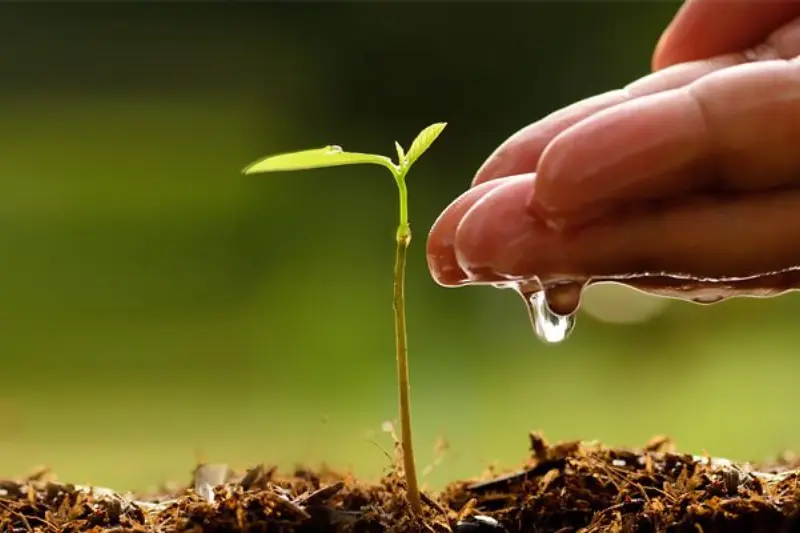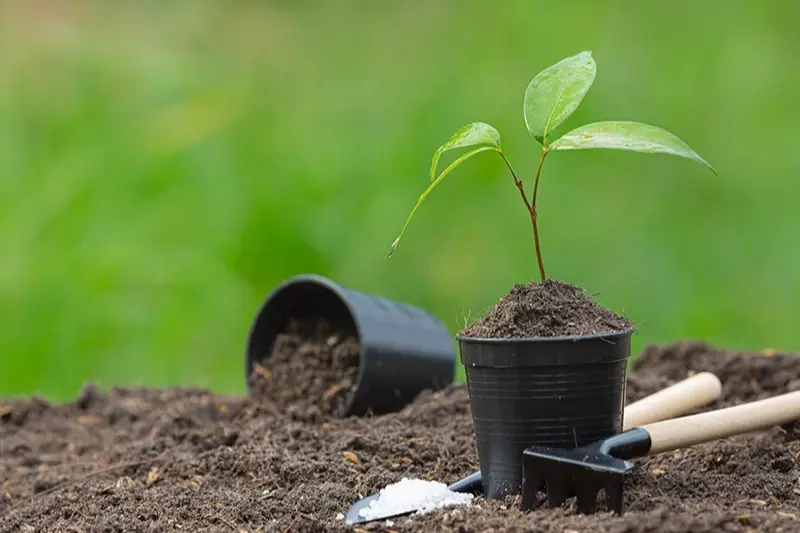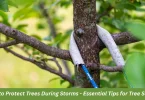Introduction
Trees are one of the most valuable parts of any backyard. They provide shade, clean the air, offer homes to birds and insects, and make outdoor spaces more relaxing and beautiful. But like any other living thing, trees need regular care to stay healthy and strong.
Whether you’ve just planted a new tree or have a large, mature tree that’s been there for years, knowing how to take care of it is important. In this post, we’ll share easy and effective tree care tips for 2025. From watering and pruning to watching out for pests and using the right tools, you’ll learn how to keep your backyard trees in great shape all year round.
What Is “How to Care for Trees in Your Backyard”?

Caring for trees in your backyard means giving them the attention they need to stay healthy, grow properly, and live a long life. It’s about doing small, regular tasks that help trees stay strong and safe in different weather and seasons.
Tree care includes watering, pruning, checking for pests or diseases, protecting the roots, and giving the soil the right nutrients. Just like people or pets, trees can get stressed, sick, or damaged—and they depend on you to notice the signs and take action.
Taking care of your trees also helps your home. Healthy trees can increase your property’s value, lower your energy bills by giving shade, and make your yard a more enjoyable place to spend time.
In short, tree care is all about making sure your trees stay happy, healthy, and beautiful—now and for many years to come.
FintechZoom.com Nickel Price Guide & Insights
What is Market – Step By Step Complete Guide
Silver Price Fintechzoom – Live Updates, Charts & Expert Analysis
Why Tree Care Is Important
Taking care of the trees in your backyard isn’t just about appearance—it’s about keeping your landscape, environment, and even your home in good shape. Here are some key reasons why regular tree maintenance matters:
Health and Longevity of Trees
- Regular care helps trees grow stronger and live longer.
- Pruning and watering reduce the risk of disease and damage.
- Healthy trees are better able to handle storms, pests, and climate changes.
Safety for Your Home and Family
- Dead or weak branches can fall and cause injury or property damage.
- Regular inspections help spot issues before they become serious hazards.
Improved Property Value
- Well-maintained trees add beauty and structure to your yard.
- Healthy, mature trees can increase your home’s resale value.
Environmental Benefits
- Trees absorb carbon dioxide and release oxygen, improving air quality.
- Their roots prevent soil erosion and support local wildlife habitats.
- Shade from trees can lower your energy bills in the summer.
Cost Savings Over Time
- Preventative care is often much cheaper than emergency removal or repair.
- Early detection of pests or disease can save a tree from dying or spreading issues to others.
Personal Enjoyment and Well-being
- A healthy tree creates a peaceful, shady space for relaxing or entertaining.
- Green spaces are known to reduce stress and improve mental health.
Step-by-Step Guide: How to Care for Trees in Your Backyard

Taking care of your trees doesn’t have to be complicated. Follow these simple steps to help your backyard trees grow strong, stay healthy, and look great all year round.
Step 1: Identify the Tree Type
- Learn what kind of tree you have (oak, maple, pine, etc.).
- Each tree species has different needs for water, sunlight, soil, and care.
- Use plant ID apps or ask a local nursery for help if you’re not sure.
Step 2: Water Properly
- Water young trees deeply once or twice a week, especially in hot months.
- Mature trees may only need water during dry spells.
- Water slowly at the base to reach the roots—avoid shallow, quick watering.
Step 3: Apply Mulch
- Add 2–4 inches of organic mulch around the base of the tree.
- Keep mulch a few inches away from the trunk to prevent rot.
- Mulch helps retain moisture, prevent weeds, and protect roots from heat and cold.
Step 4: Prune Carefully
- Remove dead, damaged, or crossing branches with clean, sharp tools.
- Do major pruning in late winter or early spring before new growth.
- Avoid cutting too much at once, especially in hot or dry seasons.
Step 5: Check for Pests and Diseases
- Look for signs like holes in leaves, sticky residue, spots, or bark damage.
- Treat early with eco-friendly sprays or natural solutions if needed.
- If unsure, call a professional to check for serious issues.
Step 6: Protect the Trunk and Roots
- Don’t hit the trunk with lawn mowers or weed trimmers—use a barrier if needed.
- Avoid piling soil or mulch against the trunk.
- Don’t park vehicles or place heavy items over the root zone.
Step 7: Feed the Soil
- Test your soil every couple of years for nutrients and pH level.
- Add compost or organic fertilizers as needed, based on your tree type.
- Healthy soil supports strong root growth and overall tree health.
Step 8: Plan for the Seasons
- Water more during hot, dry months.
- Prune during dormancy (late winter).
- Protect young trees in winter with wraps if needed.
Advantages and Disadvantages of Caring for Trees in Your Backyard
Like any home or garden task, taking care of trees comes with its pros and cons. Understanding both sides can help you make better decisions and plan your tree maintenance effectively.
| Advantages | Disadvantages |
| Regular care keeps trees strong, less prone to disease, and more likely to live longer. | Regular tree care (watering, pruning, monitoring) takes time and attention. |
| Well-maintained trees improve the appearance and resale value of your home. | Professional arborist services, soil tests, or treatments can be expensive, especially for large trees. |
| Trees clean the air, provide shade, reduce carbon dioxide, and support wildlife. | Improper pruning or watering can damage or even kill a tree. |
| Trees provide natural cooling in summer, helping reduce the need for air conditioning. | Some trees attract insects or can spread disease to nearby plants if not properly maintained. |
| Pruning and inspections reduce the risk of falling branches or tree damage during storms. | Storms, drought, or extreme temperatures can complicate tree care and require extra effort. |
Making Money from Home – Simple Tips and Ideas to Start Earning Today
Best Ways to Earn Money – Easy and Effective Methods to Boost Your Income
Money Management Tips – Simple Steps to Take Control of Your Finances
Frequently Asked Questions (FAQs) About Backyard Tree Care
How often should I water my backyard trees?
For young trees, water deeply once or twice a week. Mature trees usually only need water during hot or dry weather. Always water slowly at the base so the roots can absorb the moisture.
When is the best time to prune a tree?
The best time to prune most trees is late winter or early spring—before new leaves grow. Avoid pruning in fall or during extreme heat. Remove dead or broken branches any time of year.
Do I need to use fertilizer for my trees?
Not always. Many trees get what they need from the soil. But if your tree looks weak or your soil is poor, a slow-release, organic fertilizer or compost can help. A soil test can tell you exactly what your tree needs.
Is mulch really necessary?
Yes! Mulch helps hold moisture in the soil, keeps weeds away, and protects roots from heat and cold. Just don’t pile it against the tree trunk—leave a few inches of space.
Can I trim large branches myself?
It’s better not to. Trimming large or high branches can be dangerous. If the job involves a ladder, power tools, or heavy limbs, call a professional tree service.
How do I protect tree roots?
Avoid stepping or driving over roots, especially when the ground is wet. Keep heavy equipment and vehicles away. Use mulch to protect the root zone, but don’t overdo it.
Conclusion
Taking care of trees in your backyard doesn’t have to be difficult. With a little time and the right steps—like watering, pruning, and checking for problems—you can keep your trees healthy and strong for years to come. Healthy trees add beauty, shade, and value to your home. Start small, stay consistent, and don’t be afraid to ask for help when needed. Your trees will thank you with years of growth and greenery.
Bonus Tips for Tree Care Success
Want to go the extra mile? These bonus tips can help you give your trees even better care:
- Use a Rain Gauge:Keep track of how much rain your yard gets so you don’t over- or under-water your trees.
- Plant at the Right Time:The best time to plant new trees is in early spring or fall when the weather is cooler and the soil is moist.
- Avoid Over-Pruning:Only remove what’s necessary. Cutting too much can stress the tree and slow down its growth.
- Create a Tree Care Calendar:Mark reminders for watering, mulching, and checking for pests each season to stay on track.
- Recycle Yard Waste:Use fallen leaves and branches as compost or mulch to naturally feed your soil.
- Support Wildlife:Let trees provide shelter for birds and insects. Healthy trees support a healthy ecosystem in your backyard.
- Keep Tree Records:Note planting dates, pruning times, or any treatments you’ve done. It helps you spot patterns and catch problems early.
Stock Market for Beginners – How to Start in the Stock Market with Confidence
How to Invest in the Stock Market: A Step-by-Step Guide for Beginners
Stock Market Analysis Tools – Key Features and Benefits for Traders and Investors







[…] How to Care for Trees in Your Backyard – Tree Maintenance Tips 2025 […]
[…] How to Care for Trees in Your Backyard – Tree Maintenance Tips 2025 […]
[…] How to Care for Trees in Your Backyard – Tree Maintenance Tips 2025 […]